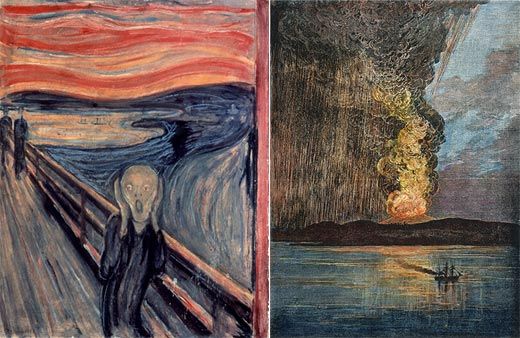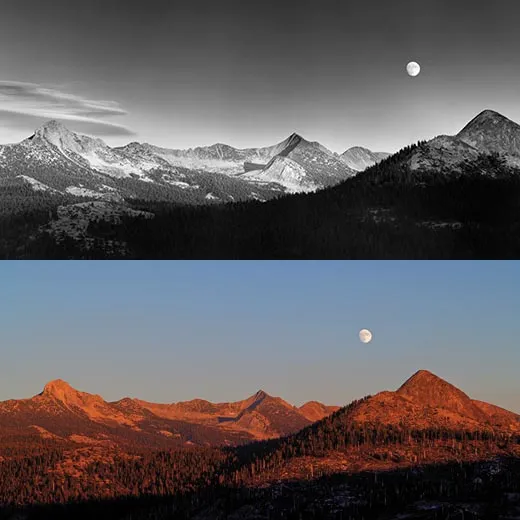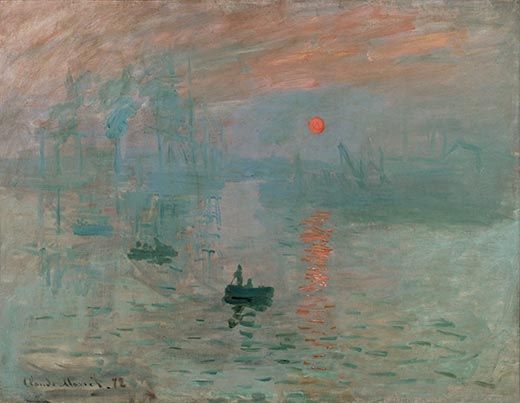Forensic Astronomer Solves Fine Arts Puzzles
Astrophysicist Don Olson breaks down the barriers between science and art by analyzing literature and paintings from the past
/https://tf-cmsv2-smithsonianmag-media.s3.amazonaws.com/filer/Ansel-Adams-Autumn-Moon-631.jpg)
In painter Edvard Munch's Girls on the Pier, three women lean against a railing facing a body of water in which houses are reflected. A peach-colored orb appears in the sky, but, curiously, casts no reflection in the water. Is it the Moon? The Sun? Is it imaginary? Does it matter?
To Donald Olson, an astrophysicist at Texas State University, the answer to the last question is an emphatic yes. Olson solves puzzles in literature, history and art using the tools of astronomy: charts, almanacs, painstaking calculations and computer programs that map ancient skies. He is perhaps the leading practitioner of what he calls "forensic astronomy." But computers and math can take him only so far.
For Girls on the Pier, Olson and his research partner, Texas State physicist Russell Doescher, traveled to Asgardstrand, Norway, the resort town where Munch made the painting in the summer of 1901. By mapping the area and studying old postcards, the pair determined the exact location of the original pier (which had been torn down), the heights of the houses and the spot where Munch likely stood. They then retraced the paths of the Sun and the Moon across the sky at the time Munch was there.
They concluded that the setting Sun did not appear in that section of sky at that time, but the Moon did. As for the missing reflection, it was not an artistic choice, as some art historians had proposed, but a matter of optics: from the artist's perspective, the row of houses blocked it.
Reactions to the findings have varied. "Olson makes points that art historians have managed to miss, such as how Munch was a very careful observer of the natural world," says art historian Reinhold Heller, author of the 1984 biography Munch: His Life and Work. But Sue Prideaux, author of 2005's Edvard Munch: Behind the Scream, offers only caustic praise. "I think that it's absolutely splendid that two such learned scientists as Don Olson and Russell Doescher bend their considerable brainpower to decoding Munch rather in the manner of crossword addicts. Photographic fidelity was never Munch's aim." Prideaux adds that Munch was interested in capturing the feeling of a moment and that objective details were of little consequence to him. As he himself once wrote, "Realism is concerned only with the external shell of nature....There are other things to be discovered, even broader avenues to be explored."
"You can't ruin a painting's mystique through technical analysis," Olson says. "It still has the same emotional impact. We are just separating the real from the unreal."
Olson, 61, began his scientific career exploring Einstein's theory of general relativity. He worked on computer simulations of the radiation near black holes and the distribution of galaxies. In other words, he spent his days inside a lab delving into topics that few people outside the lab understood. Then, one evening two decades ago, he and his wife, Marilynn, an English professor also at Texas State, attended a faculty party at which one of Marilynn's colleagues mentioned having difficulties with some passages in Chaucer's Canterbury Tales—they were loaded with astronomical references. Chaucer was no mere stargazer—he wrote an entire treatise on the astrolabe, an instrument used to calculate the positions of stars and planets—and sections of "The Franklin's Tale" deal in technical language with the prediction of a strange mammoth tide. Olson agreed to help decipher the passages. "I can remember exactly where I was standing in the room because that moment changed my life," he says of accepting that challenge.
Analyzing computer simulations of the positions of the Moon and Sun, Olson surmised that a phenomenon described by Chaucer—"And by his magic for a week or more / It seemed the rocks were gone; he'd cleared the shore"—occurred in 1340. That year, when the Sun and Moon were at their closest points to Earth, they lined up in an eclipse of the Sun; their combined gravity caused extremely high tides off the coast of Brittany.
"Most people see liberal arts on one side and sciences on the other, but I get to break those barriers down," Olson says, though he admits that he now gives relativity relatively short shrift. "I would love to know what happened before the Big Bang," he says, "but I don't think I'm smart enough to figure that out." He adds that he prefers "problems that are challenging but solvable."
Not long after Olson dealt with Chaucer, James Pohl, a history professor at Texas State and a former marine, came to him with a different sort of problem. Pohl had been studying the November 1943 Allied assault on the Pacific island of Tarawa, in which U.S. Marine landing craft were unexpectedly grounded on a coral reef about 600 yards offshore. The marines had to disembark and wade to the beach while exposed to heavy enemy fire. More than 1,000 were killed. Pohl wanted Olson to explain what had gone wrong.
Olson figured out that the marines' assault had taken place on one of two days that year when the Moon was farthest from Earth and also in its quarter phase, creating an unusually low tide. "When people have asked me who was to blame, I can tell them with confidence that the answer is no one," says Olson.
World War II war correspondent Robert Sherrod, who had been at the battle, presented Olson's conclusions at a reunion of Tarawa survivors and told Olson that the marines were gratified that there was a scientific explanation. And a military historian included the findings in his account of the battle.
While researching Tarawa, Olson came across another amphibious-landing mystery. In Julius Caesar's account of his invasion of Britain in 55 B.C., the general wrote that after seeing the enemy atop high cliffs (of Dover), he ordered his fleet to put ashore several miles away. But the exact location of where it landed has been debated by historians for centuries: historical descriptions seem to match a spot to the northeast, but currents that day would have taken the ships southwest.
Since coming across the puzzle 20 years ago, Olson has been collecting information about it, including a firsthand account of the battle by a Roman soldier. In 2007, Olson even sailed to the site himself to test conditions. That's when he figured out that Caesar had to have put in at a point to the northeast, near the town of Deal, as historical descriptions suggest. The date given in Caesar's history—or in the transcribed copies that remain—had to be wrong, and the landing must have taken place on August 22 or 23, not the 26th, as Caesar has it.
Olson published his Caesarean findings—one of the most recent of about 50 puzzles he has solved—in the August 2008 issue of Sky & Telescope magazine, whose readers (professional and amateur astronomers), he expects, check his calculations. (So far, he's not been found in error.)
Olson also investigated the sinking of the USS Indianapolis at the end of World War II. Two torpedoes from a Japanese submarine struck the heavy cruiser around midnight on July 30, 1945. The resulting explosion killed 300 sailors, and the ship sank in the Philippine Sea, casting 900 men into shark-infested waters. Only 317 survived to be rescued four days later. The Navy charged the ship's captain, Charles B. McVay, with negligence for failing to evade enemy fire. He was court-martialed and demoted, despite protests from men under his command that he was following standard procedures and testimony from the Japanese sub commander that McVay could not have escaped the attack. McVay committed suicide in 1968. He was exonerated in 2000 by a Congressional resolution that declared "the American people should now recognize Captain McVay's lack of culpability for the tragic loss of the USS Indianapolis and the lives of the men who died."
The case piqued Olson's interest. After reading survivors' accounts, researching weather conditions and analyzing astronomical data at the time of the attack, Olson concluded that the submarine had surfaced just when the Indianapolis was in the glittering path of the Moon's reflection, allowing the Japanese to see it silhouetted from ten miles away but obscuring the submarine from the Americans' view. And once it was spotted, "the ship was doomed," he says.
In addition to puzzles in history, literature and art, Olson also likes photographic puzzles, such as the one he posed to students in an Astronomy in Art History and Literature course he taught at Texas State: When did Ansel Adams capture his celebrated Yosemite National Park image Moon and Half Dome? Although Adams kept careful technical records—noting shutter speeds, f-stops, lenses and film—he rarely dated his negatives, to the frustration of art historians. In the case of Moon and Half Dome, Adams noted only that he had taken it in 1960.
After a field trip to view Yosemite's cliffs and using clues from the photograph—the amount of snow on the ground, the phase of the Moon and the depth of the shadows on the granite dome—Olson and his students concluded that the photograph had been taken at 4:14 p.m. on December 28, 1960. And since they also determined that the Moon and Sun would be in nearly identical places at 4:05 p.m. on December 13, 1994, dozens of Adams fans and even a couple of the photographer's relatives, including his daughter-in-law and grandson, went to the park on that day to shoot their own versions of the iconic photograph.
Olson and another group of students took on Adams' Autumn Moon, a panorama of Yosemite Valley that had been dated in various books to either 1944 or 1948. A series of photographs of the valley taken by a park ranger in 2004 helped them pinpoint where Adams likely took the picture, while weather records and the angle of the Moon helped narrow down the day. Shadows in a color photograph of the scene that Adams took two and a half minutes before he made the black-and-white exposure (based on the position of the Moon) gave clues to the Sun's location and the time of the shot. Olson determined that it had been taken at 7:03 p.m. on September 15, 1948.
He was then able to predict when the light and seasonal conditions would be virtually identical, and he and hundreds of Adams fans ventured to the spot at the appointed time. At 6:52 p.m. on September 15, 2005, Olson's colleague Doescher snapped a photograph that looks eerily similar to Adams' masterpiece. "In a project like this, the journey is its own reward," says Olson. "We not only got to walk in Adams' footsteps, we got to understand the circumstances under which he took the photograph. And the truth is, I think he was prepared. I think he knew that moment in nature was coming."
A starry sky in a work of art often catches Olson's eye—he is an astronomer, after all—and starts him thinking about how he might identify the stars and just when they were captured. "He brings the power of the stars to bear upon our understanding," says art historian Paul Tucker of the University of Massachusetts at Boston. Tucker teaches Olson's work in his class because "pinpointing the time period or a particular moment can have real bearing on the meaning of a picture."
Olson has tackled three van Gogh paintings, including White House at Night, one of more than 70 that van Gogh created in Auvers-sur-Oise in the weeks before he committed suicide, on July 29, 1890. (He hasn't published any findings on van Gogh's Starry Night, saying it's "not simple" to identify the stars in the painting.) When Olson and several of his students traveled to the town, about 20 miles outside Paris, they discovered that the house identified in most guidebooks as the one in the painting didn't have the right number of windows and faced the wrong direction. Once they found the right house—after walking every street in town—it was relatively easy to deduce from celestial calculations and weather reports that the star in the White House painting was actually the planet Venus as it appeared above the house near sunset on June 16, 1890.
Olson delved into Munch's best-known work, The Scream, in 1995. About the time Munch painted it, in 1893, the artist wrote himself a note—which Olson read with the help of Norwegian dictionaries—about a walk he had taken at sunset years earlier, on which "a flaming sword of blood slashed open the vault of heaven—the atmosphere turned to blood—with glaring tongues of fire...and truly I heard a great scream."
In Oslo, Olson located the road featured in a sketch for the painting. Details in it—a cliff, a road with a railing and an island in a fjord—indicated to Olson that Munch must have been facing southwest when he drew it. Olson concluded that the painting's blood-red sky was no metaphor but the extraordinary aftereffects of the 1883 eruption of Mount Krakatoa in Indonesia, which sent so much gas and ash into the atmosphere that skies were darkened or colored worldwide for many months.
Some Munch experts have challenged Olson's interpretation. Biographer Prideaux points out that Munch expressed contempt for realism in painting and "stated that his purpose was to paint the vision of the soul." Furthermore, "you'd hardly call the figure [in The Scream] realist, so why the sky?" And art historian Jeffery Howe of Boston College notes that Munch didn't paint The Scream until ten years after Krakatoa erupted. Howe admits that Munch "might have remembered the scene and painted it later," as the artist's note suggests, but Howe remains unpersuaded.
Olson insists his finding doesn't diminish Munch's creation. "How many people in Europe saw the Krakatoa twilights?" he says. "It would be hundreds of thousands, even millions. And how many people created a painting that people talk about more than a hundred years later? One. We think [our work] doesn't reduce Munch's greatness; it enhances it."
Olson now is working on an analysis of the skies in three other Munch paintings. After that, Claude Monet's Impression, Sunrise. In the 1970s, John Rewald, an Impressionist scholar, asked whether the painting's sunrise might actually be a sunset. Tucker tried his hand at the problem in 1984, consulting period maps and photographs of Le Havre, where Monet painted the piece, and concluded that the artist had indeed captured a sunrise. But, he said, "I would be more than happy to be corrected, and if [Olson] were able to bring scientific [and] astronomical issues to bear, all the better."
Whatever his findings, Olson's forays into art and literature are likely to keep stirring the debate about the sources of great art. His work may not change the way we see Munch or Adams or Chaucer, but it does tell us at least a bit about their three-dimensional worlds. And from there, we can see where the true genius begins.
Jennifer Drapkin is a senior editor at Mental Floss magazine. Sarah Zielinski is a Smithsonian assistant editor.





